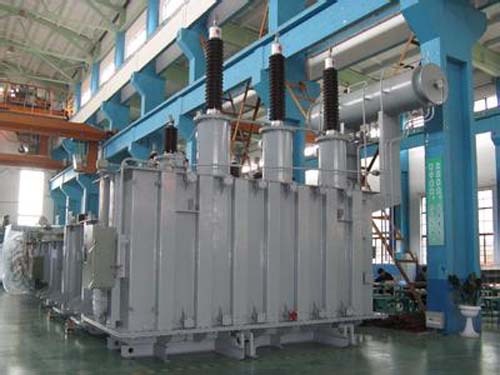
First, the purpose and significance of the load test
The load test of the transformer is to short-circuit the wire ends of the windings on one side of the transformer and to supply the rated current of the rated frequency on the other side. At this time, the rated current flows through the coils on both sides, thereby generating a leakage magnetic flux. In addition to the resistance loss caused by the rated current in the winding, the loss caused by the leakage flux in the winding and in the structure is called the nearby loss. Together they are called the load loss, which is the loss measured during the load test. The rated voltage applied to the short-circuit winding during the load test is the impedance voltage, which is generally expressed as a percentage of the rated voltage.
Regardless of the size of the transformer, the load loss accounts for most of the total loss. By analyzing the load loss, the structural and manufacturing defects of the transformer can be checked. Impedance voltage is also one of the important conditions for parallel operation of transformers.
Second, the relevant standards and requirements of the load test
1. Impedance voltage and load loss should meet the requirements of GB1094.1.
2. The load test shall be performed on the main tap.
3. The two-winding transformer supplies the rated current from one side of the sample, and the other side is short-circuited and measured only once. The three-winding transformer should be conducted between pairs of windings, and the other windings open.
Second, the load test method
Transformer load test is usually to make one side of the larger rated current winding short circuit, the other side of the winding is rated tap position, the rated current rated frequency is applied, at this time, the measured loss is the load loss, the measured voltage The percentage of rated voltage is the impedance voltage (standard value). Both power meter and three-power meter measurements for single-phase transformers and three-phase transformers are basically the same as the wiring diagram for no-load tests.
Four, three-phase transformer single-phase load test
The single-phase load test of the three-phase transformer is based on the comparison and analysis of the two-phase load loss, and the distribution of the load loss in each phase is observed to find the defects of the winding in the manufacture. It is an effective method for finding faults.
When the power supply windings are star-connected, the power supply shall be distributed from the higher voltage side AB, BC, CA, and the rated current shall be applied. The loss of the AB phase shall be PAB, the voltage shall be UAB, and the loss of the BC phase shall be PBC. The voltage is UBC; the load loss of the CA phase is PCA and the voltage is UCA.
When the power supply windings are delta-connected, in addition to the dual-phase application of the power supply, one phase should be short-circuited in sequence (A-phase short-circuit, BC-phase power supply; B-phase short-circuit, AC power supply; C-phase short circuit, AB-phase power supply)
The main function of the MPPT Solar Controller is to realize maximum power point tracking (MPPT) in the solar power generation system to improve the energy utilization efficiency of solar panels. It is an advanced charge controller that can adjust the output voltage and current of the Solar Panel in real-time to keep the solar panel operating at the maximum power output point.
Main effect:
Maximum power point tracking: MPPT Solar Controller can accurately calculate the maximum power output point of the solar panel by monitoring the voltage and current of the solar panel in real-time and according to the characteristics of the solar panel. It then adjusts the panel's output voltage and current to keep it operating at its maximum power output point, maximizing the solar panel's energy conversion efficiency.
High energy utilization rate: MPPT Solar Controller's maximum power point tracking function can ensure that the solar panel is always operating in the best working condition, making full use of solar energy, thereby improving the energy utilization rate of the photovoltaic power generation system.
Charge control: In addition to achieving maximum power point tracking, MPPT Solar Controller also has a charge control function to protect the battery from overcharge and over-discharge damage.
Differences from other charge controllers:
Maximum power point tracking function: MPPT Solar Controller is a charge controller specially used in solar power generation systems. The biggest difference is that it has a maximum power point tracking function, which is used to improve the energy conversion efficiency of solar panels. Other charge controllers may not have this unique feature.
Energy efficiency: MPPT Solar Controller can improve the energy efficiency of solar panels through maximum power point tracking technology. Other charge controllers may only be able to charge in a fixed manner and cannot achieve maximum power point tracking.
Application scenarios: MPPT Solar Controller is mainly used in solar power generation systems, while other charge controllers may be suitable for different types of energy generation systems, such as wind power, hydropower, etc.
Overall, the main role of the MPPT Solar Controller is to achieve maximum power point tracking, improve the energy conversion efficiency of the solar panel, and protect the battery from overcharge and over-discharge damage. Compared with other charge controllers, it has unique advantages in energy utilization efficiency and maximum power point tracking and is suitable for applications in solar power generation systems.
10 amp mppt solar charge controller, solar charge controller 10 amp, 36v mppt solar charge controller, dc dc mppt charger, lithium ion solar charge controller
Ningbo Autrends International Trade Co., Ltd. , https://www.china-energystorage.com